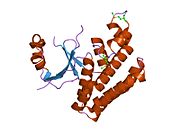| OTUB2 | |||||||||||||||||||||||||||||||||||||||||||||||||||
|---|---|---|---|---|---|---|---|---|---|---|---|---|---|---|---|---|---|---|---|---|---|---|---|---|---|---|---|---|---|---|---|---|---|---|---|---|---|---|---|---|---|---|---|---|---|---|---|---|---|---|---|
 | |||||||||||||||||||||||||||||||||||||||||||||||||||
| |||||||||||||||||||||||||||||||||||||||||||||||||||
| Identifiers | |||||||||||||||||||||||||||||||||||||||||||||||||||
| Aliases | OTUB2, C14orf137, OTB2, OTU2, OTU deubiquitinase, ubiquitin aldehyde binding 2 | ||||||||||||||||||||||||||||||||||||||||||||||||||
| External IDs | OMIM: 608338; MGI: 1915399; HomoloGene: 57056; GeneCards: OTUB2; OMA:OTUB2 - orthologs | ||||||||||||||||||||||||||||||||||||||||||||||||||
| |||||||||||||||||||||||||||||||||||||||||||||||||||
| |||||||||||||||||||||||||||||||||||||||||||||||||||
| |||||||||||||||||||||||||||||||||||||||||||||||||||
| |||||||||||||||||||||||||||||||||||||||||||||||||||
| |||||||||||||||||||||||||||||||||||||||||||||||||||
| Wikidata | |||||||||||||||||||||||||||||||||||||||||||||||||||
| |||||||||||||||||||||||||||||||||||||||||||||||||||
Ubiquitin thioesterase OTUB2 is an enzyme that in humans is encoded by the OTUB2 gene.
Otubains are deubiquitinating cysteine proteases (DUBs; see MIM 602519) that belong to the ovarian tumor (OTU) protein superfamily. Like other DUBs, otubains cleave proteins precisely at the ubiquitin (UB; see MIM 191339)-protein bond.
References
- ^ ENSG00000277276 GRCh38: Ensembl release 89: ENSG00000089723, ENSG00000277276 – Ensembl, May 2017
- ^ GRCm38: Ensembl release 89: ENSMUSG00000021203 – Ensembl, May 2017
- "Human PubMed Reference:". National Center for Biotechnology Information, U.S. National Library of Medicine.
- "Mouse PubMed Reference:". National Center for Biotechnology Information, U.S. National Library of Medicine.
- Balakirev MY, Tcherniuk SO, Jaquinod M, Chroboczek J (Apr 2003). "Otubains: a new family of cysteine proteases in the ubiquitin pathway". EMBO Rep. 4 (5): 517–22. doi:10.1038/sj.embor.embor824. PMC 1319179. PMID 12704427.
- ^ "Entrez Gene: OTUB2 OTU domain, ubiquitin aldehyde binding 2".
Further reading
- Rual JF, Venkatesan K, Hao T, et al. (2005). "Towards a proteome-scale map of the human protein-protein interaction network". Nature. 437 (7062): 1173–8. Bibcode:2005Natur.437.1173R. doi:10.1038/nature04209. PMID 16189514. S2CID 4427026.
- Gerhard DS, Wagner L, Feingold EA, et al. (2004). "The status, quality, and expansion of the NIH full-length cDNA project: the Mammalian Gene Collection (MGC)". Genome Res. 14 (10B): 2121–7. doi:10.1101/gr.2596504. PMC 528928. PMID 15489334.
- Nanao MH, Tcherniuk SO, Chroboczek J, et al. (2005). "Crystal structure of human otubain 2". EMBO Rep. 5 (8): 783–8. doi:10.1038/sj.embor.7400201. PMC 1299112. PMID 15258613.
- Namciu SJ, Friedman RD, Marsden MD, et al. (2004). "Sequence organization and matrix attachment regions of the human serine protease inhibitor gene cluster at 14q32.1". Mamm. Genome. 15 (3): 162–78. doi:10.1007/s00335-003-2311-y. PMID 15014966. S2CID 8594824.
- Ota T, Suzuki Y, Nishikawa T, et al. (2004). "Complete sequencing and characterization of 21,243 full-length human cDNAs". Nat. Genet. 36 (1): 40–5. doi:10.1038/ng1285. PMID 14702039.
- Heilig R, Eckenberg R, Petit JL, et al. (2003). "The DNA sequence and analysis of human chromosome 14". Nature. 421 (6923): 601–7. Bibcode:2003Natur.421..601H. doi:10.1038/nature01348. PMID 12508121.
- Strausberg RL, Feingold EA, Grouse LH, et al. (2003). "Generation and initial analysis of more than 15,000 full-length human and mouse cDNA sequences". Proc. Natl. Acad. Sci. U.S.A. 99 (26): 16899–903. Bibcode:2002PNAS...9916899M. doi:10.1073/pnas.242603899. PMC 139241. PMID 12477932.
| PDB gallery | |
|---|---|
This article on a gene on human chromosome 14 is a stub. You can help Misplaced Pages by expanding it. |





